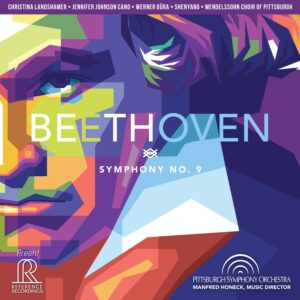Tracks:
- I Allegro ma non troppo, un poco maestoso (14:32)
- II Molto vivace (13:12)
- III Adagio molto e cantabile (12:34)
- IV. Finale (22:30)
Christina Landshamer, soprano
Jennifer Johnson Cano, mezzo-soprano
Werner Güra, tenor
Shenyang, bass-baritone
Mendelssohn Choir of Pittsburgh (Matthew Mehaffey, music director)
Pittsburgh Symphony Orchestra, Manfred Honeck (conductor)
The Beethoven Symphony No. 9 is perhaps the most revered of all classical music. Ensembles making recordings of it range from the globally most prestigious to the obscure, inspired township amateurish. Considering even the most reliable and respected names among philharmonics and orchestras and conductors churned out widely comparable and none the more distinguished readings decades after decades, it is clear the listener’s choice remain more or less the same around a handful of recordings from days of old.
Any orchestra can play the Beethoven Ninth, but few can sustain a progressing coherency of the most studied score in live performances, made all the more manageable in the perfection process of laborious and mundane recording sessions. One wonders the rationale of the release of the innumerous live recordings past and present, for only the best that are far and few in between need apply.
But the present SACD from Reference Recordings is hardly a stoic reading of the Maestro’s proudest work. For the record, this Ninth is one of the fastest in recent memory that is also likable. The precision of the orchestra is beyond reprieve, and the frighteningly accelerated tempos with the ultra tonal definition positively leave an impression, while the whole experience reeks of the German culture positively. In fact, the Pittsburgh SO sounds more natively Beethoven than many Western and Eastern European ensembles.
This recording is from the FRESH! series from Reference Recordings. Like most of the releases under the FRESH! imprint, it was not recorded by the RR team; in this case, the live recording was made and post-produced in DSD256 by Boston-based Soundmirror.
The Presto and “Ode to Joy” is among the most purveying and thrilling I’ve heard. Once again, there are goosebumps inducing, spectacular definition and contrasting dynamics, atop a precision in the performance to die for. The Adagio Third Movement opens with such majesty as to usurp the first movement Allegro, although this is also swifter in duration and thus paler in effectiveness compared to other notable recordings.
Controversially, here is Honeck flexing his macro treatment of the work again so as to convey a highly, meticulously crafted musical journey in the same way he conducted the Bruckner Ninth, and again something got glossed over inevitably. In this case, it’s the supposedly, eternally reverberating Adagio. Coming in after the first two fulfilling movements, the Adagio from so many earlier recordings has always been the assured crowd pleaser, but though articulate- and beautiful-sounding as this recording most certainly is, the euphoria is never given the moment to flower and thus to hypnotize the listener. I suppose I’m just hard to please.
Finally, there is Honeck’s reading of the Finale Fourth Movement, which is incessantly swift throughout hence equalizing all passages and diminishes the drama in some parts.
On the positive side, it is obvious that individual players of the Pittsburgh Symphony Orchestra were given a much higher degree of individual highlight this time, and their level of artistry rose to the challenge, contrasting some recordings of the same work by European orchestras as too conforming seemingly. As a result, moments of spontaneity and vibrancy abound. Of course, having the audiophile recording label Sound Mirror at the helm only purveyed capturing of contrasting dynamics between instrument groups in the widest range possible.
The case for such seminal and epical work as the Beethoven Ninth is how to present the music as continuously fresh sounding throughout the hour long performance. Music Director Honeck begins by keeping the players in top form, ready to unleash seemingly superhuman tenacity in precision unity and tonal clarity.
If you prefer the ultra coherent playing in established performances from the eighties, then you’ll probably find this SACD wanting still, but just give it time. Demands of the audiophile listener of the twenty-first century far eclipse those of us still stuck in the eighties, and Sound Mirror obliged with a reference caliber chronicle of the music-making session of minimalistic editing and processing.
Looks like faster tempos are now the norm at PSO under Honeck. Whether this is a good thing or not we’ll have to see, but there’s very high likelihood that the cooperative is within reach of further greatness from greater perfection in the precision of each note. After the initial listening, I had the urge to put on my reference recording of the work from the eighties so as to recapture what I’d missed. But then I did the unthinkable, I remained seated and pressed PLAY again. Another hour slipped past.
All in all, it is yet another triumph for the collaboration that is the Pittsburgh Symphony Orchestra, Music Director Manfred Honeck and Sound Mirror.
Review system:
PS Audio DirectStream Power Plant 20 AC regenerator
Acoustic Sciences Corporation TubeTraps
Audio Reference Technology Analysts EVO interconnects, power cable
Audio Reference Technology Analysts SE interconnects, power cables
Audio Reference Technology Super SE interconnects, power cables
Audio Research DAC 9
Aurender N-1000SC caching music server/streamer
Bricasti Design M21 dual-mono DAC
Esoteric K-01XD SACD player/USB DAC
T+A MP3100 HV multi-source SACD player
Pass Laboratories Xs Preamp
Pass Laboratories XA200.8 pure class A monoblocks
Bricasti Design M28 class AB monoblocks
Sound Lab Majestic 645 electrostatic panels
Copy editor: Dan Rubin
- (Page 1 of 1)



The first thing that came to mind was ” not another Beethoven 9″… The only thing more redundant would be another 5th